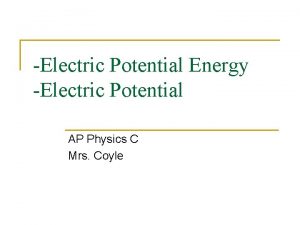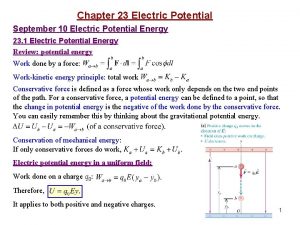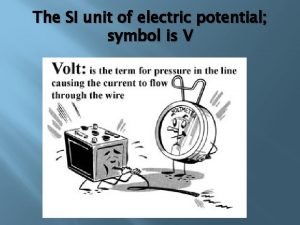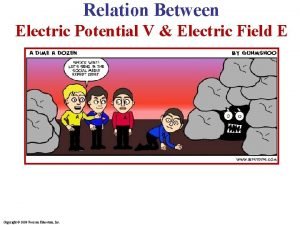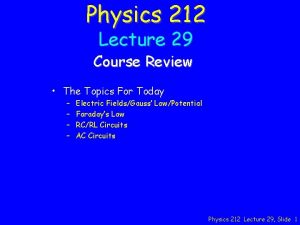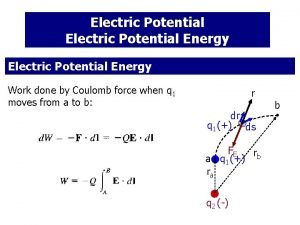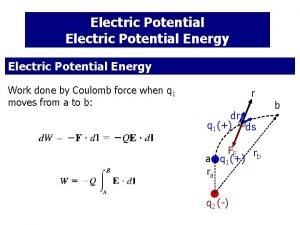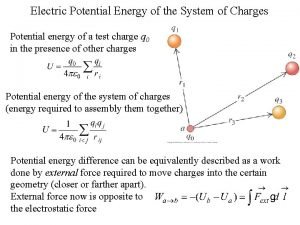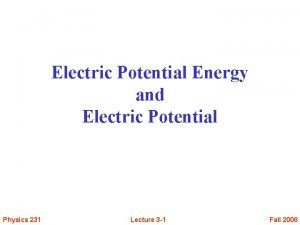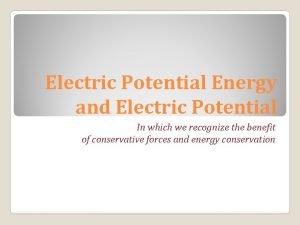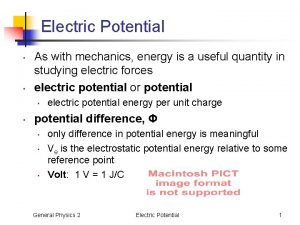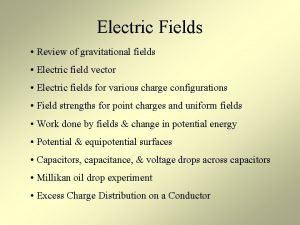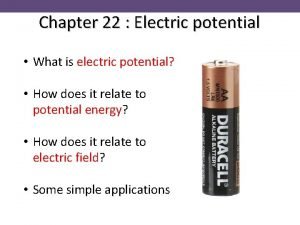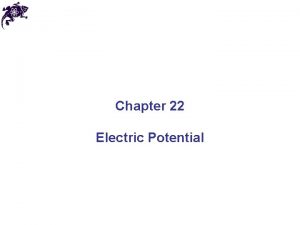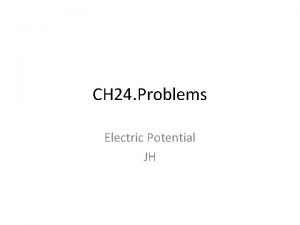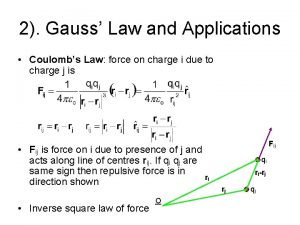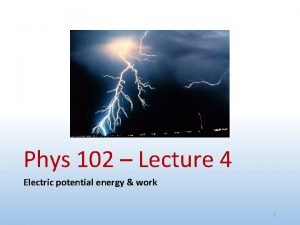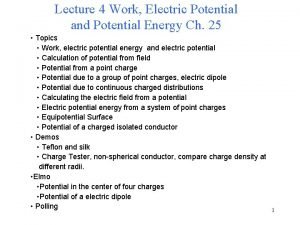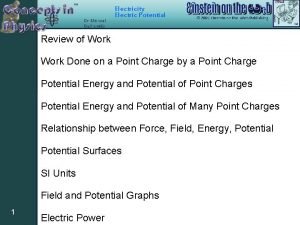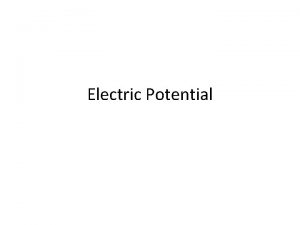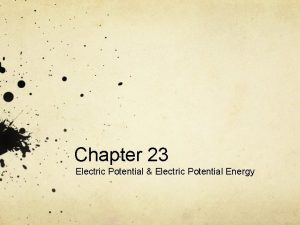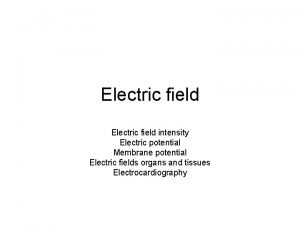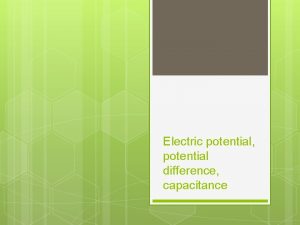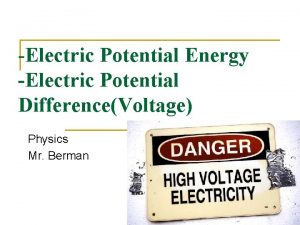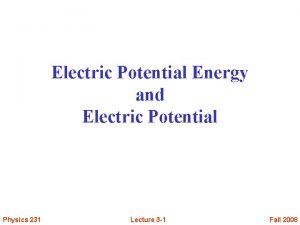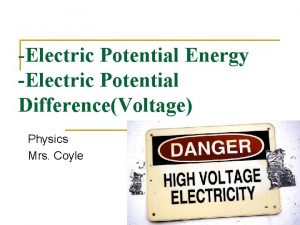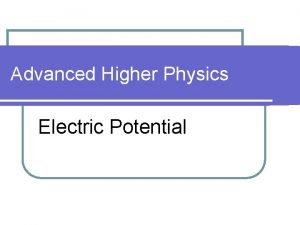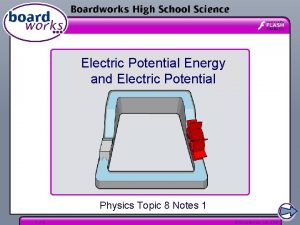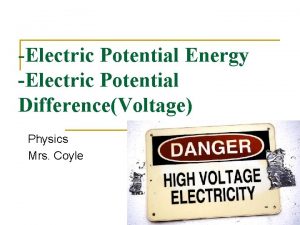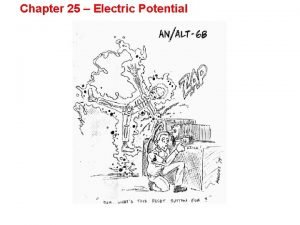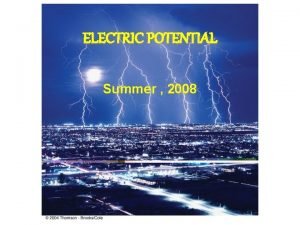Storyline Chapter 24 Electric Potential Physics for Scientists


































































- Slides: 66

Storyline Chapter 24: Electric Potential Physics for Scientists and Engineers, 10 e Raymond A. Serway John W. Jewett, Jr.

Electric Potential and Potential Difference modify

Electric Potential and Potential Difference modify The electric field is a measure of the rate of change of the electric potential with respect to position.

Electric Potential

Quick Quiz 24. 1 Part I In the figure, two points A and B are located within a region in which there is an electric field. How would you describe the potential difference V = VB VA? (a) It is positive. (b) It is negative. (c) It is zero.

Quick Quiz 24. 1 Part I In the figure, two points A and B are located within a region in which there is an electric field. How would you describe the potential difference V = VB VA? (a) It is positive. (b) It is negative. (c) It is zero.

Quick Quiz 24. 1 Part II In the figure, two points A and B are located within a region in which there is an electric field. How would you describe the change in potential energy of the charge–field system for this process? (a) It is positive. (b) It is negative. (c) It is zero.

Quick Quiz 24. 1 Part II In the figure, two points A and B are located within a region in which there is an electric field. How would you describe the change in potential energy of the charge–field system for this process? (a) It is positive. (b) It is negative. (c) It is zero.

Potential Difference in a Uniform Electric Field

Potential Difference in a Uniform Gravitational Field

Equipotential Surfaces

Quick Quiz 24. 2 The labeled points in the figure are on a series of equipotential surfaces associated with an electric field. Rank (from greatest to least) the work done by the electric field on a positively charged particle that moves from A to B, from B to C, from C to D, and from D to E.

Quick Quiz 24. 2 The labeled points in the figure are on a series of equipotential surfaces associated with an electric field. Rank (from greatest to least) the work done by the electric field on a positively charged particle that moves from A to B, from B to C, from C to D, and from D to E. B to C, C to D, A to B, D to E

Example 24. 1: The Electric Field Between Two Parallel Plates of Opposite Charge A battery has a specified potential difference V between its terminals and establishes that potential difference between conductors attached to the terminals. A 12 -V battery is connected between two parallel plates as shown in the figure. The separation between the plates is d = 0. 30 cm, and we assume the electric field between the plates to be uniform. (This assumption is reasonable if the plate separation is small relative to the plate dimensions and we do not consider locations near the plate edges. ) Find the magnitude of the electric field between the plates.

Example 24. 1: The Electric Field Between Two Parallel Plates of Opposite Charge

Example 24. 2: Motion of a Proton in a Uniform Electric Field

Example 24. 2: Motion of a Proton in a Uniform Electric Field

Electric Potential and Potential Energy Due to Point Charges

Electric Potential and Potential Energy Due to Point Charges

Electric Potential and Potential Energy Due to Point Charges

Electric Potential and Potential Energy Due to Point Charges

Quick Quiz 24. 3 Part I In the figure, take q 2 to be a negative source charge and q 1 to be a second charge whose sign can be changed. If q 1 is initially positive and is changed to a charge of the same magnitude but negative, what happens to the potential at the position of q 1 due to q 2? (a) It increases. (b) It decreases. (c) It remains the same.

Quick Quiz 24. 3 Part I In the figure, take q 2 to be a negative source charge and q 1 to be a second charge whose sign can be changed. If q 1 is initially positive and is changed to a charge of the same magnitude but negative, what happens to the potential at the position of q 1 due to q 2? (a) It increases. (b) It decreases. (c) It remains the same.

Quick Quiz 24. 3 Part II In the figure, take q 2 to be a negative source charge and q 1 to be a second charge whose sign can be changed. When q 1 is changed from positive to negative, what happens to the potential energy of the two-charge system? (a) It increases. (b) It decreases. (c) It remains the same.

Quick Quiz 24. 3 Part II In the figure, take q 2 to be a negative source charge and q 1 to be a second charge whose sign can be changed. When q 1 is changed from positive to negative, what happens to the potential energy of the two-charge system? (a) It increases. (b) It decreases. (c) It remains the same.

Example 24. 3: The Electric Potential Due to Two Point Charges As shown in the figure, a charge q 1 = 2. 00 C is located at the origin and a charge q 2 = 6. 00 C is located at (0, 3. 00) m. (A) Find the total electric potential due to these charges at the point P, whose coordinates are (4. 00, 0) m.

Example 24. 3: The Electric Potential Due to Two Point Charges (B) Find the change in potential energy of the system of two charges plus a third charge q 3 = 3. 00 C as the latter charge moves from infinity to point P.

Example 24. 3: The Electric Potential Due to Two Point Charges You are working through this example with a classmate and she says, “Wait a minute! In part (B), we ignored the potential energy associated with the pair of charges q 1 and q 2!” How would you respond?

Obtaining the Value of the Electric Field from the Electric Potential

Obtaining the Value of the Electric Field from the Electric Potential

Quick Quiz 24. 4 Part I In a certain region of space, the electric potential is zero everywhere along the x axis. From this information, you can conclude that the x component of the electric field in this region is (a) zero, (b) in the positive x direction, or (c) in the negative x direction.

Quick Quiz 24. 4 Part I In a certain region of space, the electric potential is zero everywhere along the x axis. From this information, you can conclude that the x component of the electric field in this region is (a) zero, (b) in the positive x direction, or (c) in the negative x direction.

Quick Quiz 24. 4 Part II Suppose the electric potential is +2 V everywhere along the x axis. From this information, you can conclude that the x component of the electric field in this region is (a) zero, (b) in the positive x direction, or (c) in the negative x direction.

Quick Quiz 24. 4 Part II Suppose the electric potential is +2 V everywhere along the x axis. From this information, you can conclude that the x component of the electric field in this region is (a) zero, (b) in the positive x direction, or (c) in the negative x direction.

Electric Potential Due to Continuous Charge Distributions

Problem-Solving Strategy: Calculating Electric Potential 1. Conceptualize. 2. Categorize 3. Analyze 4. Finalize

Example 24. 4: The Electric Potential Due to a Dipole An electric dipole consists of two charges of equal magnitude and opposite sign separated by a distance 2 a as shown in the figure. The dipole is along the x axis and is centered at the origin. (A) Calculate the electric potential at point P on the y axis.

Example 24. 4: The Electric Potential Due to a Dipole (B) Calculate the electric potential at point R on the positive x axis.

Example 24. 4: The Electric Potential Due to a Dipole (C) Calculate V and Ex at a point on the x axis far from the dipole.

Example 24. 4: The Electric Potential Due to a Dipole Suppose you want to find the electric field at a point P on the y axis. In part (A), the electric potential was found to be zero for all values of. Is the electric field zero at all points on the y axis?

Example 24. 5: Electric Potential Due to a Uniformly Charged Ring (C) Find an expression for the electric potential at a point P located on the perpendicular central axis of a uniformly charged ring of radius a and total charge Q.

Example 24. 5: Electric Potential Due to a Uniformly Charged Ring (B) Find an expression for the magnitude of the electric field at point P.

Example 24. 6: Electric Dipole Due to a Uniformly Charged Disk A uniformly charged disk has radius R and surface charge density . (A) Find the electric potential at a point P along the perpendicular central axis of the disk.

Example 24. 6: Electric Dipole Due to a Uniformly Charged Disk

Example 24. 7: Electric Potential Due to a Finite Line of Charge A rod of length , located along the x axis has a total charge Q and a uniform linear charge density . Find the electric potential at a point P located on the y axis a distance a from the origin

Example 24. 6: Electric Dipole Due to a Uniformly Charged Disk (B) Find the x component of the electric field at a point P along the perpendicular central axis of the disk.

Example 24. 7: Electric Potential Due to a Finite Line of Charge

Example 24. 7: Electric Potential Due to a Finite Line of Charge What if you were asked to find the electric field at point P ? Would that be a simple calculation?

Conductors in Electrostatic Equilibrium 1. E = 0 inside conductor 2. Charge resides on surface of isolated conductor 3. E at point just outside conductor, perpendicular to surface, has magnitude / 0 4. Irregularly shaped conductor: greatest where radius of curvature smallest

Conductors in Electrostatic Equilibrium E = 0 inside conductor

Conductors in Electrostatic Equilibrium Charge resides on surface of isolated conductor

Electric Fields and Charged Conductors E at point just outside conductor, perpendicular to surface, has magnitude / 0

Electric Fields and Charged Conductors Irregularly shaped conductor: greatest where radius of curvature smallest The surface of any charged conductor in electrostatic equilibrium is an equipotential surface: every point on the surface of a charged conductor in equilibrium is at the same electric potential. Furthermore, because the electric field is zero inside the conductor, the electric potential is constant everywhere inside the conductor and equal to its value at the surface.

Electric Potential and Electric Field of Charged Conductor

Surface Charge Density on Charged Conductior

Surface Charge Density on Charged Conductior

A Cavity Within a Conductor

Faraday Cage

Quick Quiz 24. 3 Your younger brother likes to rub his feet on the carpet and then touch you to give you a shock. While you are trying to escape the shock treatment, you discover a hollow metal cylinder in your basement, large enough to climb inside. In which of the following cases will you not be shocked? (a) You climb inside the cylinder, making contact with the inner surface, and your charged brother touches the outer metal surface. (b) Your charged brother is inside touching the inner metal surface and you are outside, touching the outer metal surface. (c) Both of you are outside the cylinder, touching its outer metal surface but not touching each other directly.

Quick Quiz 24. 3 Your younger brother likes to rub his feet on the carpet and then touch you to give you a shock. While you are trying to escape the shock treatment, you discover a hollow metal cylinder in your basement, large enough to climb inside. In which of the following cases will you not be shocked? (a) You climb inside the cylinder, making contact with the inner surface, and your charged brother touches the outer metal surface. (b) Your charged brother is inside touching the inner metal surface and you are outside, touching the outer metal surface. (c) Both of you are outside the cylinder, touching its outer metal surface but not touching each other directly.

Example 24. 8: A Sphere Inside a Spherical Shell A solid insulating sphere of radius a carries a net positive charge Q uniformly distributed throughout its volume. A conducting spherical shell of inner radius b and outer radius c is concentric with the solid sphere and carries a net charge 2 Q. Using Gauss’s law, find the electric field in the regions labeled 1, 2, 3, and 4. The figure and the charge distribution on the shell when the entire system is in electrostatic equilibrium.

Example 24. 8: A Sphere Inside a Spherical Shell

Example 24. 8: A Sphere Inside a Spherical Shell How would the results of this problem differ if the sphere were conducting instead of insulating?

Assessing to Learn The electric potential at two points in space is V 1 = 200 volts and V 2 = 300 volts. Which of the following statements is true for moving a point charge q from point 1 to 2? A. The work done by an external agent to move q from point 1 to 2 is positive. B. We can't determine the work done because we don't know the direction of V at the two points. C. The work done by the electric force exerted on q in moving it from point 1 to 2 is W = –q(100 V). 1. A 2. B 3. C 4. A and B 5. A and C 6. B and C 7. A, B, and C 8. None of the above

Assessing to Learn Which of the following charge distributions has the lowest potential energy? 1. 2. 4. 3. 5.

Assessing to Learn Which of the following charge distributions has the lowest electric potential at the origin? 1. 2. 4. 3. 5.
 Electrical potential energy
Electrical potential energy Define electric potential and potential difference.
Define electric potential and potential difference. Electric potential energy
Electric potential energy Electric potential inside non conducting sphere
Electric potential inside non conducting sphere Potential of conductor
Potential of conductor Pe q
Pe q Energy electric field equation
Energy electric field equation Electric potential is
Electric potential is Ap physics c electric potential
Ap physics c electric potential Chapter 33 conceptual physics
Chapter 33 conceptual physics Chapter 23 electric potential
Chapter 23 electric potential Electrical potential
Electrical potential Chapter 21 electric charge and electric field
Chapter 21 electric charge and electric field Chapter 21 electric charge and electric field
Chapter 21 electric charge and electric field Units for coulombs
Units for coulombs Units of a charge
Units of a charge Conceptual physics chapter 35
Conceptual physics chapter 35 Conceptual physics chapter 23 electric current
Conceptual physics chapter 23 electric current The lorax storyline
The lorax storyline Storyline iklan
Storyline iklan Udvikling i storyline
Udvikling i storyline Vanity fair plot
Vanity fair plot Sweeney todd storyline
Sweeney todd storyline What are the seven life processes of living things
What are the seven life processes of living things The chief story
The chief story What is storyline in drama
What is storyline in drama Storyline afs
Storyline afs Ladu macbeth
Ladu macbeth Storyline módszer
Storyline módszer How to find pressure potential
How to find pressure potential Calculating water potential
Calculating water potential How to find ionization constant for water potential
How to find ionization constant for water potential Graded potential vs action potential
Graded potential vs action potential Graded potential vs action potential
Graded potential vs action potential Action potential
Action potential Action potential definition
Action potential definition Saltatory conduction
Saltatory conduction Osmotic potential vs water potential
Osmotic potential vs water potential Source of bioelectric potential isin nature.
Source of bioelectric potential isin nature. Transmission across a synapse
Transmission across a synapse Intubating dose succinylcholine
Intubating dose succinylcholine Action potential resting potential
Action potential resting potential Action potential resting potential
Action potential resting potential Sales potential vs market potential
Sales potential vs market potential Symbol for electric potential
Symbol for electric potential Relation between electric field and potential
Relation between electric field and potential Electric potential inside non conducting sphere
Electric potential inside non conducting sphere Dipole electric field
Dipole electric field Topographic map cliff
Topographic map cliff Electric potential difference
Electric potential difference Gpe =mgh
Gpe =mgh Coulomb force potential energy
Coulomb force potential energy Potential energy of an electric field
Potential energy of an electric field Electric potential unit
Electric potential unit Definition of potential gradient
Definition of potential gradient Electrostatic potential energy
Electrostatic potential energy Ev to volt
Ev to volt Intrinsic property examples
Intrinsic property examples Capaciton
Capaciton Electric potential analogy
Electric potential analogy What is the potential at point a
What is the potential at point a Electric potential problems and solutions
Electric potential problems and solutions Application of coulomb's law
Application of coulomb's law Can potential energy be negative
Can potential energy be negative Electric potential lecture
Electric potential lecture Electric potential to work
Electric potential to work Absolute potential energy
Absolute potential energy








